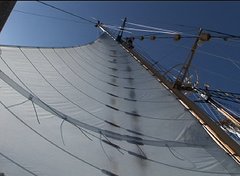After a delightful short trip from Tahiti across gentle seas we anchored in Cook’s Bay in the center of an ancient volcano. The anchorage was surrounded by lush green, jagged peaks and a tranquil setting for our ship orientations and safety briefings. We gazed at crystal blue waters and a gorgeous sunset set while feasting on a home cooked dinner on deck.

The Robert Seamans anchored in Cook's Bay
The next morning we left in the morning for Rangaroa, the second largest Atoll in the world. Fair breezes from the west made sailing easy and by midday we had most of our lower canvas up. Students are quickly learning the rig of the RCS. Science stations have started and CTD casts (an instrument that measures physical parameters of the water column) and water samples for a variety of projects have been collected. The Class has quickly mastered many instruments as we had a rapid succession of stations collecting microbiology samples from a Long Term Ecological site off Moorea for a project funded in part by the Census of Marine Life (CoML), nutrient and carbon samples from depths along the track and than some net tows into the water column. Dr. Dunbar’s team has successfully installed a sophisticated instrument for sampling total carbon in the surface waters allowing several projects to make some major measurements along our cruise track that will inform the team about the oceans role in the carbon cycle.
It's been a quick and successful start.
Dr. Barbara Block


No comments:
Post a Comment